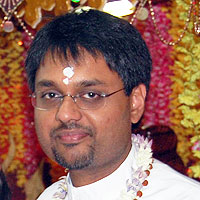From a satsang with Pt. Dr. Umesh Persad
Devi represents energy. Energy is that which makes things happen. We have just concluded worship of the Das Mahaa Vidya, or the Great Principles of Wisdom, that are embodied in the forms of the 10 Devis during the period of Nau Raatri. However, our goal as devotees is to continue to discover the practical application of Devi in our everyday lives that will assist us to advance on the spiritual path.
The 10 Wisdom Principles are:
- Kaali
- Taaraa
- Tripura Sundaari
- Bhuvaneshwari
- Tripura Bhairavi
- Chinnamastaa
- Dhoomavati
- Bhagalaamukhi
- Maatangi
- Kamala
The first five Devis are known as the five main principles of existence. The second five represent five methods of inner transformation, that is, yogic techniques.
The first Devi is Kaali, who is said to have been a projection of Ambaa Devi. She destroyed the demon, Raktabeej, who would multiply whenever a drop of his blood was spilled. The name Kaali means the power of time. Time can be described simply as a measure of change. In the flow of time, there is past, present and future: The past was once the present. The present is what the future once was. The future is what will become present at some point in time.
In reality, time does not exist; it is a delusion created by our minds. If we reflect on the concept of time, we will realise that there is only the perpetual Now. Time is only created in our own minds because of memory; without memory, time would be meaningless. We must realise that we all live in the infinite present moment. Thus, the first practical application of Kaali Devi in our lives is to contemplate the nature of change and time.
The second application of the Kaali principle is to observe the inner clock in our body, the breath. Merging our consciousness with this inflowing and outflowing breath is true Kaali worship. The act of observing the breath settles the mind and body and we can then cope with the external changes that time causes.
The third practical application of Kaali Devi is meditation. Kaali destroyed the demon, Raktabeej, which means ‘blood’, but also ‘to be attached to’; ‘beej’ means ‘root’ or ‘seed’. Raktabeej therefore symbolises the cause of our attachments in this life. When we drink of the desires of life, we are not settled in mind and body. Therefore, we must awaken the Shiva principle within, the principle of detachment and stillness, in order to settle the mind and advance spiritually.
By practising these three techniques that are encoded in the symbolism of Devi, we will attain her essence and realise our oneness with Divinity.



